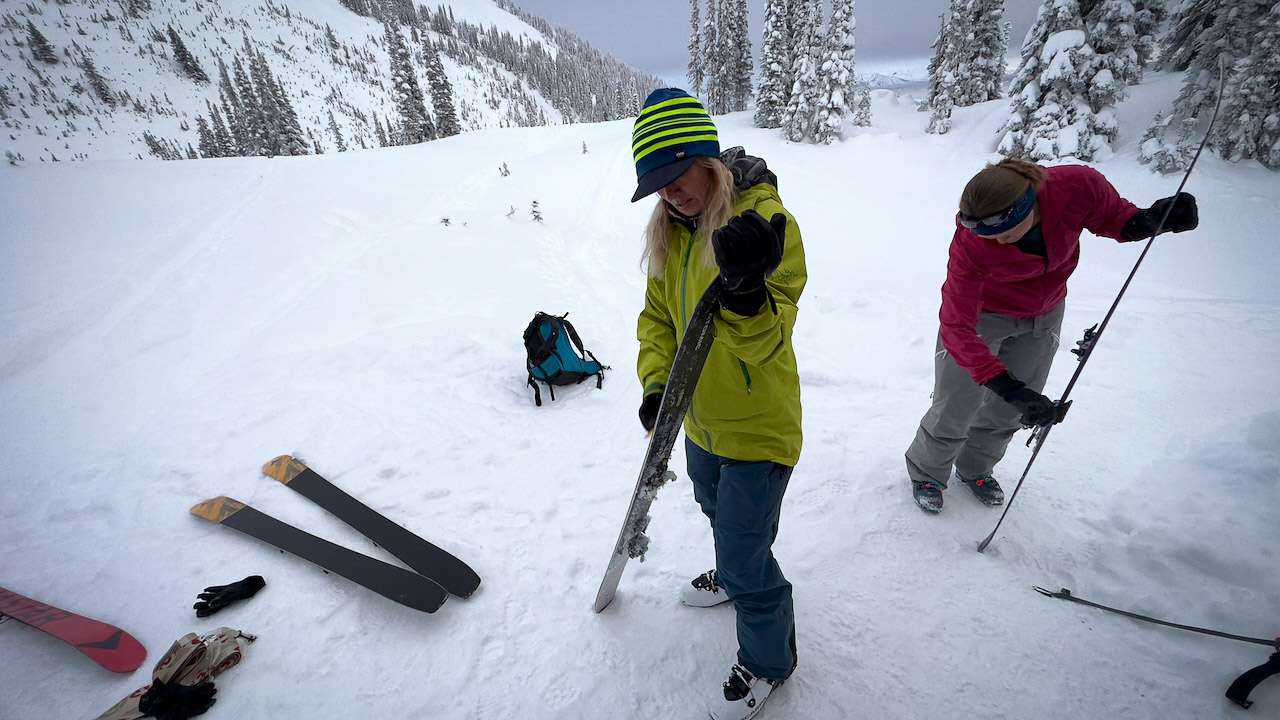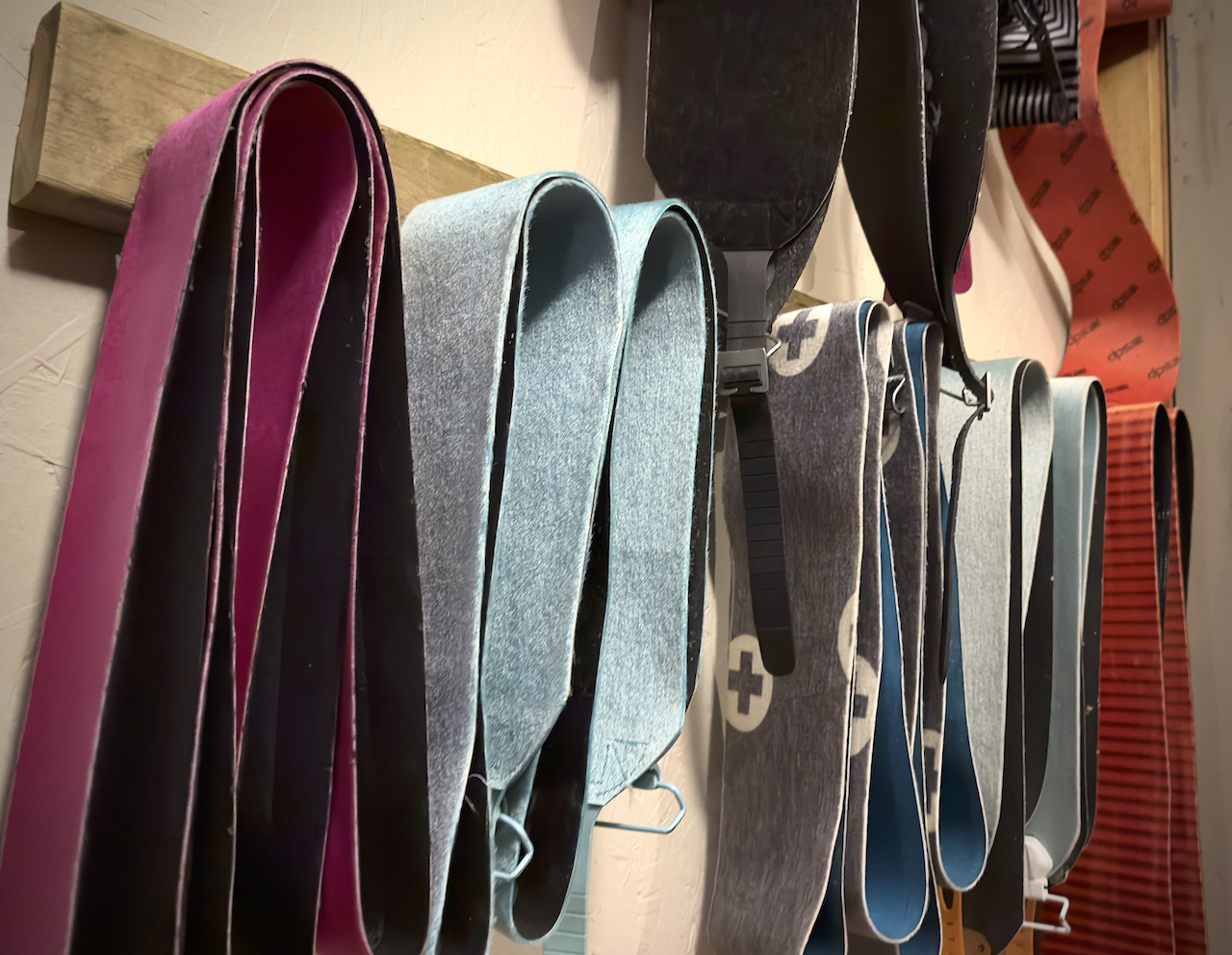Skin Basics
Skins are a layer of fabric applied to a ski base that allows for uphill travel on snow-covered slopes. A thin adhesive (skin glue) is used on one side of the skin, while the other is a plush fabric with millions of fine fibers. We’ll call this the plush. The plush’s fibers are directional: they allow the ski to slide uphill, while a downward motion causes the hairs to stand up, preventing the ski from sliding backward. It’s like dog fur—smooth while running your hand from head to tail (tip to tail), while it will resist your hand working from tail to head (tail to tip on a ski) as the “plush” stands up.
The skin sticks to the ski base with a light glue that most often works in cold and snowy environments. (Each main skin brand uses proprietary glue.) Some glues are known for their aggressive stickiness, while others allow the skin to peel off easily. Like glue, each brand also uses proprietary systems to affix to the tip and tail.

We’re focusing on types of plush in this primer. Otherwise, you need to know that skins allow for efficient upward travel. Peel off or “rip” skins at the top of your line, stow them in a pack, and allow gravity to take over.
Plush Material
Render the world of ski skins to three basic materials: Mohair, nylon, and mixed. Each material has attributes that include positives and negatives. Seasoned backcountry skiers and riders likely own several pairs of skins and use a specific plush, depending on the time of year.
Mohair:
Think of mohair as the fleet-footed cousin of the two other plushes. Mohair is sourced from Angora goat hair and is considered the lightest and fastest of the three major skin materials. Derived from our four legged mountain friends, mohair skins are also the most expensive.
Considering glide efficiency, 100% mohair skins were the benchmark for years, and they still reign. However, some mixed skins come close in terms of gliding uphill. But if you check under the skis of most fleet skied Lycra clad uphiller, for certain, they’ll have mohair carpets stuck on their skis.
In some conditions, like when a skin track steepens or ices up, pure mohair skins might not grip as well as nylon or mixed skins. Skinning technique matters too, but typically mohair’s grip loses out as the angle of ascent increases.
Where mohair wins are their speed and lightness and suppleness (more on that below); their main downside is durability. Mohair skins usually wear out faster than mixed and nylon skins. During springtime tours, when we often are skinning in the AM dark and across and up abrasive snow, mohair does not fare well. In abrasive snow conditions, mohair skins can be trashed in only a few days. Be aware if you plan on a lengthy spring volcano season in the PNW—maybe keep the precious mohair skins at home. Lastly, mohair skins tend to be less water repellent, even when treated with a hydrophobic potion, than mix or nylon plush skins.
*Suppleness: we fold skins after they are pulled from the skis and place them in a pack or jacket skin-stash pocket. Skins that fold easily and take up less volume win the day. Mohair skins are often more supple (thank you, goats), making them easier to fold into a tidy package and stash out of the way. If you use a minimalist pack (less than, say, 20L) or like to store skins in a jacket pocket as you charge and skin lap after lap of the local powder shot, then mohair might be for you.
It’s also good to remember that big wide skins for the floaty powder skis take up vital space in the pack no matter how you parse it. Mohair packs up nicely.

Mix Skins
In the world of niche sports, choices can be overwhelming. Mixed skins are a solid compromise. Mixed skins are part mohair (usually 65%-70%), with the remainder, constituted of nylon. As we’ll read in the section below, nylon is more durable than mohair. It is also slightly heavier. For many, a mix of the two materials hits the sweet spot.
We’ve used many skin brands and mock-ups over the years. There is a reason companies have arrived at the 70:30 mix—it works. Mix skins provide excellent grip and glide and suitable durability. For those looking for a plush that compromises little in the speed department and lasts an entire season of use, extending from November to June, then check out some mix skins.
The packability, a function of suppleness and how thin the skin is overall, is often a fraction more than their pure-bred mohair counterparts. Mixed skins still store efficiently, just maybe a wee bit less adequately than pure mohair.
Nylon Skins
There was a time, not so way back in the time machine when 100% nylon skins meant bulky, heavy, and sluggish. A solid skin that they were. A pair with a lifespan beyond that of a mid-size dog wasn’t unheard of.
Modern nylon skins shouldn’t weigh or slow you down too much. Add that the newer (read thinner and more pliable) nylon skins are easier to roll/fold and stash than in the past and still have boosted durability over their mohair and mohair/nylon mix counterparts, making them a good choice for those on a budget or looking for a more durable skin. As for uphill gliding and efficiency, a nice pair of nylon skins isn’t too much of a penalty these days. Modern nylon skins are a go-to for many with a spring skiing habit of skinning on refrozen slopes as the pre-dawn caffeine kicks in. If that is you, expect a pair of nylon skins to be around for several seasons. And a nylon plush skin tends to repel water better than mohair and mix skins. If you are out for an epic tour and the temps rise, their hydrophobic nature might make a difference over the long haul.
Find more information on sizing skins and tip and tail attachments.
A Word About Skin Glue
Skin glue should serve two primary functions. First, the glue should provide ample stickiness to adhere to your ski base during a full day of touring. Second, ripping skins off your ski base should be fairly effortless. In other words, yanking a skin off the ski base should be like peeling a semi-ripe banana; there’s some resistance, but not much.
We’ve used all sorts of skin glues, and like many things related to humans, some of us prefer certain glues, while others do not. In our estimation, no skin glue beats all other glues all the time. For example, Pomoca skin glues peels off easily, is durable, and provides a sweet mix of adhesiveness and e-z-to-peel-off-ness. Yet, they sometimes are prone to skin failure on cold powdery days. Conversely, G3 skin glue is a solid workhorse yet can be tough at times to peel off a ski base or if you store your skins glue-side to glue-side. However, as many Canadians have said, G3 glue works great in very cold temperatures. Take note; it gets cold in Canada.
Then there’s Contour’s Hybrid skin glue—which doesn’t feel sticky. Have no fear; the Hybrid glue adheres to a ski base, and peels off easily with no residue. This glue is its own beast of sorts and requires a cleaning/refresh occasionally, and it can begin to fail as well in cold powdery snow.
Closing Thoughts:
It is said that for backcountry gear, one should consider skins as disposable. To some extent, that may be true. If you are touring off-piste several days a week, sure, that is a heavy load of wear and tear on a pair of skins. Hammering away on a thin yet fast pair of mohair skins day after day, week after week, will diminish the mohair’s effectiveness (its ability to climb). If you sport a single ski quiver all winter and rely on the same set of mohair skins, true, they might break down. Opt for mix skins if you want greater durability with a likely imperceptible speed penalty. (We know skimo racers may have different thoughts on this as there is only one plush: mohair.) The same can be said for opting for a nylon set—they will afford a user more durability, with a cost of slightly less gliding speed.
If you are like some of us at The High Route, you might have a two or three-ski quiver. In that case, maybe it makes sense to buy nylon skins for the spring ski and a light set of mohair or mix skins for the bigger, wider, phatter powder sticks.
Think of this as a regional choice too. If you expect long approaches where more efficient glide pays dividends, mohair might be right.





Leave a Reply
You must be logged in to post a comment.